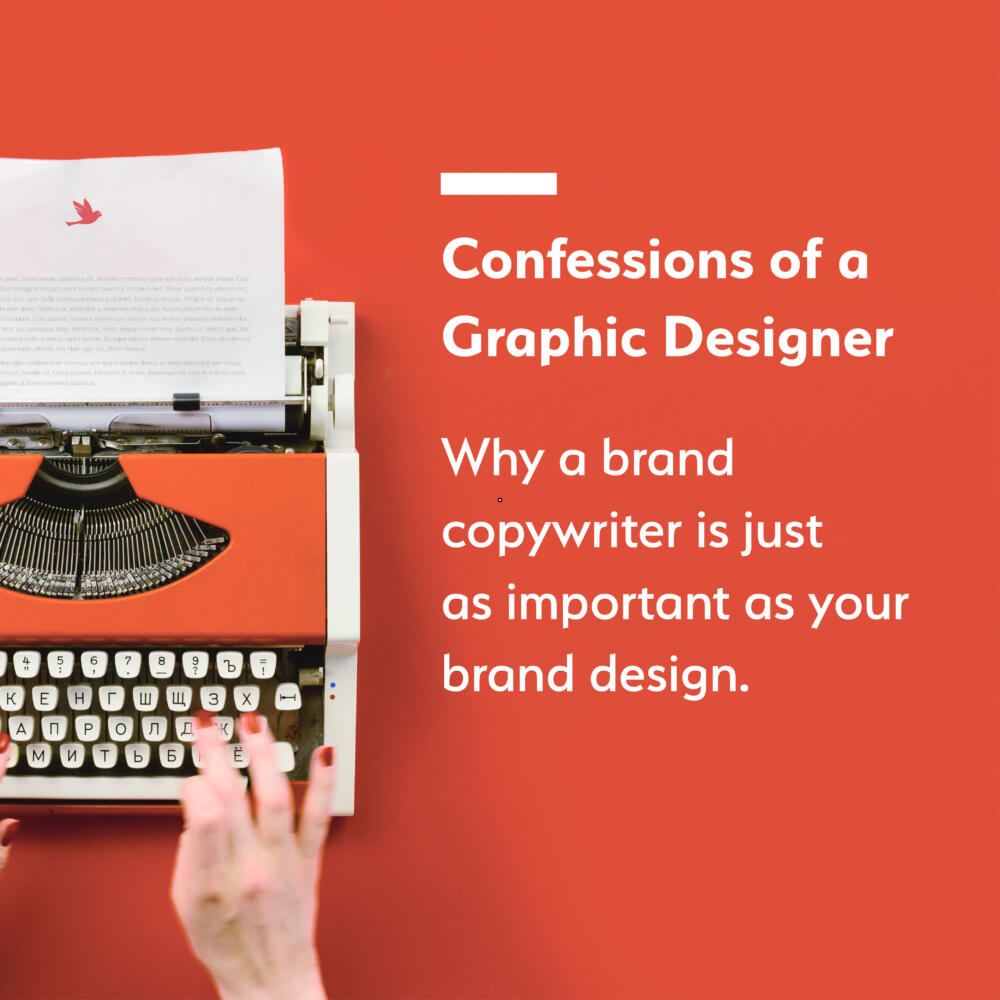I am guilty of regularly preaching about the value that an experienced graphic designer can bring to your business. But let’s be honest, the role of your copywriter is, very often, just as important.
Weaving the right words into your business brand communication, can make all the difference to how your audience perceives your business services and values.
So, what is a brand copywriter?
A brand copywriter works with you to understand the personality and values of your business and converts it into meaningful, brand-specific messages and content that nurture brand loyalty, community and customer engagement.
Your copywriter is a talented wordsmith with skills far beyond just stringing words together. They are crafting compelling narratives, building memorable brand messages and enticing engagement. In this article, I share my conversation with freelance copywriter, Sheryl Allen from Over the Page and her insights into how she works with her clients to create written copy that packs a punch!
Storytelling that sells
Cheryl (Graphic Designer): “At the heart of every successful brand lies a captivating story waiting to be told. With increasing pressure to engage audiences on social media platforms, there’s no denying the importance of sharing your brand story and tapping into the emotions, aspirations and desires of audiences to create a connection that goes beyond mere products or services of your clients.
As a copywriter with well over 20 years of experience, can you tell me how you go about translating your client’s brand values and visions into relatable stories?”
Sheryl (Copywriter): “We humans are hard-wired for storytelling. Yet, business-owners often find that brand storytelling doesn’t come naturally. My job is to drill down beneath the brand to discover the stories worth telling. Conversation is the key. A face-to-face or phone interview can reveal stories that surprise even the teller. And often some ripping quotes to humanise the copy.
I think of several key story types when I’m digging, including:
- Business origin story. How did you start? What sparked the business idea? What were you doing before? Who was your first customer? What drives you?
- Product story. Who made it? Where was it made? How are the materials/ingredients sourced?
- Client /customer story: Who has this product/service/program/idea changed? What was their problem? How did you solve it? How did they feel?
- Team member story: Who has been changed through being on your team? What’s their journey? How do they feel about it?
There are brand stories everywhere, often hiding in plain sight. I favour those that are relatable, align to business values, demonstrate progress on vision/mission, have a human element and the power to differentiate a brand from others in the market. The story gold is often in the tiny details you might otherwise dismiss.
An example: I recently developed a short piece about a craft gin distiller. My digging revealed that the owner sourced ingredients/botanicals locally. After high tide, you might find her scouring the tideline at the local surf beach, collecting fresh kelp left behind by the ocean.
That’s quite an evocative mind-image to drive a narrative piece. And it’s bang-on brand. It translates to engaging social media posts, label copy/tasting notes, press releases and more. It’s a story I’d love to hear retold across a bar as the gin’s being served to me.
Retelling one story (even one tiny detail) in myriad ways equals more bang for your buck. I believe well-articulated, relatable stories are the most powerful evergreen brand content you’ll ever create.”
Crafting brand consistency
Cheryl (Graphic Designer): “As a graphic designer, I am a strong advocate of brand consistency as a cornerstone of brand recognition. Consistency not only fosters a sense of reliability but also contributes to the development of a strong brand identity. Customers should be able to recognise a brand’s voice even without seeing its logo. This is where a brand copywriter’s expertise shines.
A brand copywriter helps maintain consistency in tone, style and language, ensuring that your brand becomes easily recognisable. I love witnessing their pivotal role in ensuring that every piece of communication, from taglines, website content, annual report copy to social media posts and product descriptions, adheres to a unified tone and brand message.
Sheryl, can you give me an insight into the types of brand copywriting you have worked on over your career and perhaps an example when the style of your written word has effectively shifted the perception of the reader?”
Sheryl (Copywriter): “I’ve always positioned as a generalist copywriter. That’s enabled me to work with and on an incredible range of brands across many industries from fashion and food, to accounting and legal, to tourism and events, and dozens more in between.
My work has often involved multiple touchpoints for a single client, helping distil their brand across web content, flyers, reports, press releases, product descriptions and so on. Keeping key messages, tone and language consistent across different applications strengthens the brand while building audience understanding and trust.
I once worked on the launch of a range of hair products on Amazon US and via a standard e-commerce website in Australia. These luxe products were squarely aimed at the female market.
My client had already settled on a tagline Luxury with love. I suggested we leverage that by amplifying the emotion of ‘love’ throughout the content.
I swapped humdrum product description headings like ‘features’ and ‘testimonials’ out for ‘What you’ll love about it’ and ‘Who else loves it’. ‘Add to cart’ became ‘Make it mine!’, ‘Read more’ became ‘What’s to love?’ and we signed off emails and packaging inclusions with ‘To hair, with love’. A loyalty club offered Sweetheart Deals … and, you get the drift. Every communication from website micro copy and Amazon product descriptions to sales/loyalty comms and packaging inserts was loved up with the same fun and connective theme.
The copy mirrored the brand with a cohesive emotive message across all channels and touchpoints. The comms helped cut-through the clutter of an overcrowded market, offering a unique customer experience along with the product. The stand-out proposition of lovable, created-for-women hair products couldn’t be clearer to the audience.”
SEO magic
Cheryl (Graphic Designer): “It’s no secret that brand copywriters understand the art of integrating search engine optimisation (SEO) strategies seamlessly into their writing for websites. By strategically incorporating relevant keywords and phrases, a professional writer can help a brand’s content rank much higher on search engine results pages. A focus on SEO in written copy can result in greater organic traffic, attracting potential customers who are actively seeking the products or services a brand offers.
Sheryl, how do you balance the need for SEO in website copy and the need to convey your client’s brand personality and tone?”
Sheryl (Copywriter): “The days of overstuffing copy with SEO keywords are (thankfully) over. Sure, keywords remain a key part of Google’s ranking algorithm, but the holy grail is natural, relevant and readable language. In the age of machine learning, getting the balance right is more critical than ever.
When I’m thinking about on-page SEO for web copy, I focus on:
- Above all else, staying true to the brand, relevant to the audience intent, and as natural/conversational in tone as I can.
- Including identified keywords early on the page, if possible. Looking for opportunities to slip them naturally into headings, sub-headings and first or second paragraphs, especially if they contain geographical terms. Hello: local search.
- Experimenting with flipping sentence structures/new sentence structures, using keywords in intra-site links within body copy or elevating calls to action higher up. Frontloading, without making it top-heavy.
- Organising page content into sections and optimising the section headings with keywords, if possible. Getting to the point early, then cascading the info down.
My personal tip: read your draft copy out loud. If it sounds stilted and disjointed, especially around the keywords, revisit it to improve the flow and rhythm.
Then it’s rinse and repeat. Over and over. Staying relevant means changing up your copy often. Checking your analytics to see what’s working (and what’s not) and iterating regularly. Small changes, made often, can make all the difference.”
Communicate directly with your target audience
Cheryl (Graphic Designer): “If you’ve identified your target audience and your ideal client, this is where your copywriter will begin. By investigating what inspires, motivates and influences your ideal client, your copywriter will create content that prompts your audience to action.
Sheryl, as a brand copywriter, how do you go about translating complex topics into memorable copy that evokes predetermined emotions in your audience and resonates with a defined audience type?”
Sheryl (Copywriter): “Understanding the target audience’s feelings is a brand copywriter’s superpower. Asking How do they feel? and How do I want them to feel? is central my process. I think about why they’re here, the problem they’re hoping to resolve and the frame of mind they might already be in.
For example, you can reasonably expect that someone seeking funeral services is feeling shocked, sad and unsure. A reassuring, caring tone along with clear pathways for decision-making could help them feel more confident and certain about their options.
Someone scouting for holiday destinations might be tired and overdue for a getaway yet overwhelmed by choice. Aspirational, imaginative copy that describes ‘moments of delight’ along with destination highlights helps them picture themselves there. Copy that focuses on the senses – the sights, the sounds, the tastes, the smells and the textures – can evoke all sorts of emotions that translate into excitement, anticipation and bums on seats.
People remember how you made them feel. For both these examples (and most copywriting projects) I start with the emotions (both existing and desired) then flesh out with the more complex stuff – required details, features, keywords and calls to action – all layered to provide a natural pathway or journey for the reader.”
A brand copywriter is your key to keeping your brand authentic
In a world where authenticity, relatability and emotional connection drive consumer behaviour, the role of a brand copywriter has never been more crucial. More than just writers, copywriters are brand architects, engagement maestros and audience motivators. Their ability to craft narratives that resonate, build consistent brand identities and optimise for search engines, makes them an indispensable asset for any business striving to stand out in a competitive landscape. So, if you’re looking to infuse your brand with a touch of magic that only words can provide, it’s time to recognise and appreciate the true value of a brand copywriter.

Sheryl writes feel-good copy that connects, compels and sells. As a professional freelance copywriter, she’s been crafting words for more than 20 years under the business moniker Over the Page.
Sheryl believes words have the power to transform how people feel, think and act. Her mission is to weave words into content that performs, that connects with people to sell an idea, a product, a service, an experience, or a message. Or, all of the above.
She works from home in Geelong West, Victoria, Australia. It’s true: sometimes she works in her PJs.

